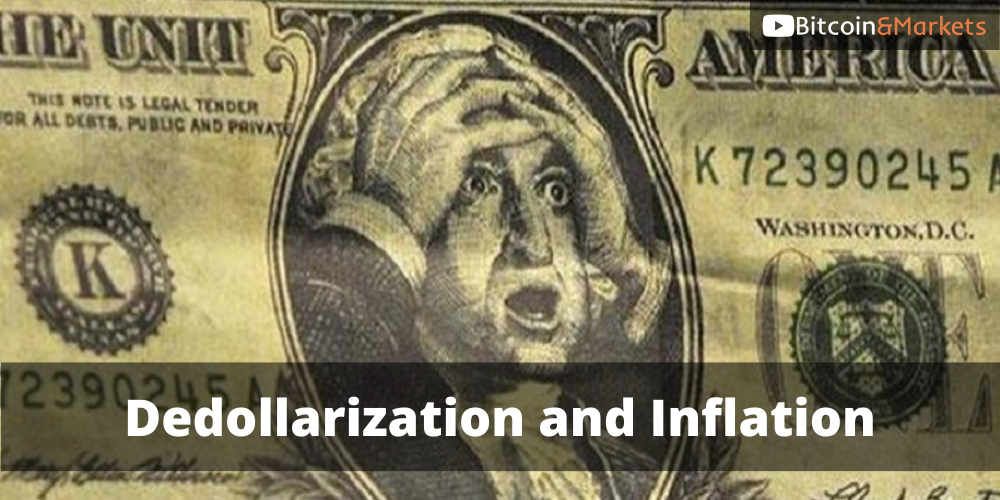Dedollarization and Inflation
What we are told about dedollarization and inflation is backwards.

You can't go through one day of macro headlines without reading something about dedollarization. It is the macro theme du jour.
As geopolitical tensions rise and the Western-led global economy struggles, we are told China and the BRICS have hegemonic desires to drop the dollar in international trade. This would lead the US to losing its "exorbitant privilege" as world reserve currency, which allows us to export inflation and artificially bolster the US economy.
We also hear a related narrative, that we are entering a new era of higher inflation. The story goes, we have become used to sub-2% inflation thinking it will continue forever, but as the world dedollarizes, the US (and Europe, who's Euro will also lose market share) can no longer export inflation.
On the surface, these two things seem to compliment each other, if China and others are using the dollar less, those dollars have to go somewhere, right? If they stay in the American economy it will cause a large rise in the number of dollars here and prices will rise accordingly.
In this post, I will show why dedollarization and inflation do not go together, and we might not get either.
The Money Ties that Bind
Let's start with dedollarization, and it's twin brother, deglobalization, saving the much-debated inflation until last.
You don't often hear dedollarization and deglobalization discussed together, even though they are two sides of the same coin. One implies the other. Unlike the overwhelming consensus on the dedollarization trend, it is much less popular to believe in deglobalization. There's many reasons for that, from the deep-seated belief that the US is an evil hegemon and all we need is to throw off US shackles and the global economy will boom, to believing in the Thucydides Trap with China, where China is a rising power and the US is a declining power. China's economic model doesn't work very well if the world deglobalizes.
Like it or not, dollarization and globalization are tightly linked through the convergence of money. In a trade network, people tend to gravitate toward one money because of that system's network effects. Not only is there efficiency in global pricing in one currency, adopting the global currency gains you access to a larger trade network. This network effect is massive and an overwhelming gravitational force.
The network effects, and the opposing exclusionary effects, are so strong, moving away from the trade networks money will have the same effects as voluntarily taking yourself out of the network completely.
I often hear people say that the US military is what backs the dollar, but the truth is, it's mostly network effects. The military, and the security framework it provided post-WWII for international institutions, is not a network effect, they are monetary characteristics of the system. If you think of a currency's home country, its banking rules, laws, taxes, court system, treaties, international influence, education of population, national income, budget deficits, default risks, etc., these are all characteristics of that money. Countries, businesses and individuals decided to adopt dollars because of the characteristics of the US system relative to all others. Their adoption then creates the network effects.
Breaking out of those network effects is very difficult, because if the system is functioning well, there's no good reason to leave. However, if the system is not functioning well, or starts to actively work against your interests, it means you are in poor economic shape to venture out on your own. The game theory is against you.
The tricky thing is how to dedollarize while not collapsing economically, AND how to get others to join you, so as to have a few competitive network effects. IOW, the negatives of staying with the dollar have to outweigh the negatives of leaving AND you have to provide an alternative system with better characteristics or there will be a giant sucking sound of business and brains leaving your country. You've probably heard the argument that innovation will leave the US if the SEC doesn't provide favorable regulations for altcoin scams. Well, if you dedollarize, business will leave your economy for the greater network effects of the dollar system. You have to be able to offer multi-nationals a reason to stay.
The currency that gets mentioned the most to replace the US dollar in bilateral trade agreements or as a reserve currency, is the Chinese renminbi. However, if deglobalization is the rule for the next couple of decades, the Chinese economic model will suffer, along with their massive credit bubble and relatively authoritarian economic system. You cannot easily believe in deglobalization and the rise of China.
To the extent dollar bears admit deglobalization is happening, they usually apply an order of operation of, first countries are dedollarizing because US hegemony is so evil, which in turn causes deglobalization pressure. That order of operation doesn't work because of the above, if you leave the global currency, you leave the global currency's network and consign your breakaway nation to economic collapse - just because you don't like your customers, the Americans. You have to be insane to dedollarize voluntarily.
The much more rational view is that deglobalization is driven by changes to the costs/benefit analysis of globalization itself, which in turn, is driving dollar shortages spun as dedollarization attempts.
Fragility of Globalization
Globalization is the integration of economies, business, and governments across the globe. It is commonly thought of as a way to cut costs by off-shoring individual steps in the production process to the lowest cost market.
Perhaps the pinnacle of globalization is the iPhone. According to their supplier list, they deal with companies in 43 countries on 6 continents, reportedly on 1400 individual components. All these companies work in an intricate ballet of supply chains to bring billions of iPhones to market. It is extremely efficient and allows for complex goods to be produced that are likely not possible without it. But it is also very fragile.
As we learned during Covid and the semi-conductor shortage, one small failure in the supply chain keeps products from coming to market. This is what I'll call a physical breakdown. Sure, it can be overcome with enough time, but the fact that the physical breakdown occurred in the first place exposes the truth, that these supply chains are not pricing in systemic chokepoints. They are underpricing risk of physical breakdowns, which is a large reason why they grew so complex in the first place.
Complex supply chains are fragile in another way, there's not only the risk of physical breakdowns, but we have been underpricing the peace dividend. For example, the average cost of insurance for a large container ship is roughly 1% of the ships total value. However, if they sail into contested waters or an active warzone, that insurance premium can rise to 10%+. If civilian ships are being attacked in that conflict, insurance climbs to 100%. In that scenario, complex supply chains become massively unprofitable.
Most people cannot conceptualize a world where globalization simply doesn't make sense because transportation costs are too high. We have lived in a bubble of ultra-low cost transportation, because of world peace among great powers and an explicit security guarantee. It's not that big of a stretch. The irrational zealotry of international conflict recently makes it easy to imagine a country purposefully attacking an oil tanker or container ship, cutting off most international shipping into a country by making it financially impossible.
Before you disregard this idea, think of the recent spat of tanker seizures between the US and Iran. In April of this year, the US seized an Iranian oil tanker enforcing their sanctions against Iranian oil. The Iranians retaliated by seizing two oil tankers in the space of a week. Just look at the list of globalized companies for the first tanker seized by Iran: Turkish-operated, Chinese-owned tanker named Advantage Sweet, which was bound for Houston, Texas carrying Kuwaiti crude oil for US energy firm Chevron Corp.
Yet another threat to globalization is trade war, tariffs on products from politically unfavored nations changes the math again. For decades this was mitigated by the World Trade Organization (WTO), one of the numerous international organizations set up by the US in the post-WWII era. If a country was treating your exports unfairly, you could take the issue to the WTO.
However, in a world where the US is the one applying tariffs and trade restrictions, the costs to globalization increases.
Globalization is under attack from all these angles. The intricate ballet of supply chains simply doesn't make business sense anymore. The time where businesses could take certain costs for granted, like redundancy in case of physical breakdowns, physical security, political arbitration and securing import vulnerabilities (e.g. having to import necessities like food, fertilizer, and energy), is over.
What was previously a no-brainer, extend and globalize supply chains, will now run in reverse. Globalization is losing its cost-saving value proposition. It is better to shrink supply chains to close allies, neighbors, or domestic sources. The music has stopped, the lights are out, yet some of the dancers are trying to continue with the show.
Inflation
Let's quickly restate the mainstream argument for how dedollarization will work to make inflation higher. We have come to expect sub-2% inflation because other countries politely took dollars in trade, which the US has been printing/abusing. Once they stop doing that, those dollars will stay in the US and cause prices to rise.
For this argument to be true, the source of dollars has to be the US. They must be printed here and have a net outflow via trade deficits. There's a problem with this view, dollars are printed, not only in the US, but everywhere through credit creation denominated in dollars. This creates more dollars and still further dollar demand. For instance, if a bank in India creates a dollar denominated loan and adds digital dollars to a borrowers account, the borrower now must repay the principle plus interest. Dollars didn't flow out of the US, they were printed outside the US.
Where does the money come from to repay principle and interest, you might ask. One way they can get it is through yet further dollar creation in their country, or via international trade. Other countries are doing the same thing, so if they settle international trade in dollars, you can get dollars for your exports to anywhere in a circular economy. Another major source will, of course, be trade with the US itself and her trade deficits.
By printing dollars outside the US, demand is created for US trade deficits. The US's trade partners want the dollars to pay the dollar denominated debts. The dollar was chosen as the foreign currency of debt issuance based on the US dollar having the best monetary characteristics at the time (as discussed above), plus the size of the currency network effects (both in balances and capital markets) and the US's ability to sustain trade deficits.
Dedollarization means you do not accept dollars in trade, cutting off inflow of dollars into your country and making it impossible for people to service their dollar debts. These are debts owed to businesses and people within the foreign country, as well as trade partners outside the country and international banks.
There are two other options to get dollars into a country that is purposefully, or not, dedollarizing, both are bad. 1) Direct foreign exchange: selling the currency they are using for dollars on the open market. This is counterproductive because it will increase the relative value of the dollar and the debt versus the currency they are doing business in. 2) More dollar denominated debt: more borrowing in dollars with less ability to get dollars. Lenders would be very hesitant to do this, and it will only cause a larger problem down the road.
Let's bring it back to the supply of money. Dedollarization is supposed to trap dollars in the US and cause prices to rise as a consequence. However, if dollars are printed outside the US and they stop accepting dollars, there will be a shortage of dollars in those nations to pay their dollar debts, causing them to get those dollars other ways including dumping other currencies to buy dollars directly. This will, in fact, strengthen the dollar. Dollars will flow out of the US either through trade deficits or through foreign exchange, there is no "trapping of dollars in the US causing prices to rise."
As foreigners default on their dollar debts and don't take out new dollar debts, because lending standards rise and demand falls due to economic collapse or because they have no way to source dollars for repayment, the global supply of dollars will actually decrease, not increase. Fewer dollars created, fewer dollars available to meet existing debts, less economic activity to qualify for a loan in the first place; all this leads to a rising dollar and shrinking supply of dollars. Dedollarization leads to deflation.
Conclusion
If the Fed's balance sheet grows by $10 trillion dollars in the next few years, even if it is money printing (a topic for another post), it will not offset the dollar destruction elsewhere caused by deglobalization and involuntary dedollarization.
I tried to show that dedollarization and the accompanying inflation narrative are backwards. Dedollarization is not voluntary, because of the economic constraints, game theory and network effects. It is an involuntary result of deglobalization. Deglobalization is driven by the resurgence of the true cost in international trade.
What we are left with is the order of operation, from deglobalization to dedollarization to deflation.
We may see some prices rise in the medium term in the US as people grapple with these changes. Realized costs are rising, hence prices will likely also rise. However, this is not inflation and cannot be prevented by monetary policy. Think of deflation at the end of a credit bubble as a monetary shortage. Monetary value will be scarce, hence prices will feel higher, so high many things we are used to will be out of reach for the common person. Don't fall into the trap of thinking that is inflation though. It is not caused by money printing, just the opposite.
The more the Fed tries to crush demand the faster the process will move. Also, the more governments force inefficient ESG, the faster their international influence will erode.




